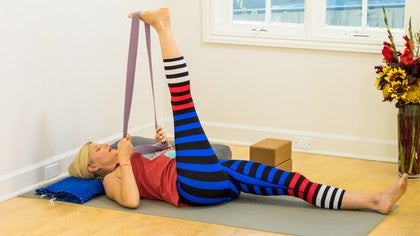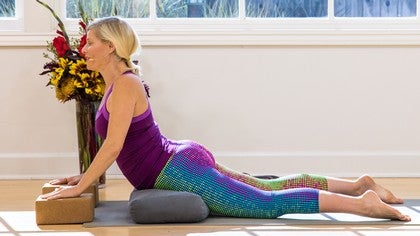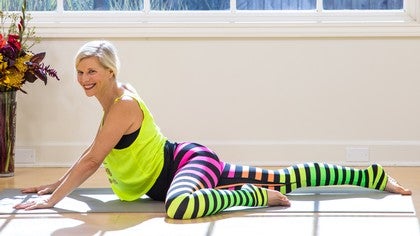Description
About This Video
Transcript
Read Full Transcript
Hi, y'all. Let's get started. So we're going to try to relax you today. So we're going to bring ourselves into butterfly pose first. I'm bringing the soles of my feet together and I'm actually going to use two blocks. I don't have to use two blocks in butterfly, but I'm going to use them today just so it's even that much more relaxing. I'm going to put the blocks underneath. You could put them underneath your knees, but I actually like them underneath my thighs. So they're holding my thighs up a little bit. The soles of my feet together. And if you are used to strict alignment, you're maybe used to pulling the heels in close. You can have more of a diamond shape. And so that's a, that might be a nice release for some of you. And then you're just going to start to lean forward and we're going to be here about three minutes. So sometimes if I'm doing this pose without the two blocks, I will use a block underneath my head, but today I'm not. The blocks are supporting my knees and my thighs enough that I'm able to just let the head relax. And notice I'm kind of shifting the blocks or I'll tell you that I'm shifting the blocks a little bit. So as I get in there and I realize that I can change them, I'm letting myself do that. Now I feel like I've kind of settled into a position that's nice and comfortable. In butterfly pose, you want to feel as comfortable as you can. The goal is to just really put yourself into a yin state. And butterfly is a good pose to do that. The reason why is it's a pose that targets the spine. You might be feeling it in the inner thighs or the groins or the outer hip. That's actually why I propped my thighs up is so I'd feel it less in the hips and more in the spine. So as I hold the pose a little bit longer, I'm able to even just slide my arms forward, drop down a little deeper. So if you are using a block to prop the head up, you might even remove the block at this point or drop the block down a level if that feels comfortable. So forward folds tend to be euphoric for most of us, perhaps not while you're in it. So if you're not feeling euphoria right now, that's okay. But just try to release, relax, let go of the spine. Trust in the sturdiness of the body and let everything just release from that sturdiness. I'm really letting my head drop down. Again, if the head feels like it's too much weight, prop it up, even just with your hands. I'm going to start to slowly move myself out of the pose. We were here about three minutes and I'm coming out nice and slow. So no hurry. We're going to come down onto the back, but I'm not even near there. So don't feel like you need to go there right away. After butterfly, I actually like to stay up for just a few breaths. So I'm removing the blocks from underneath my eyes. And then I'm just going to sit for a moment upright. And then I'm going to slowly release the legs out and maybe shift the pelvis forward, giving myself some room to come down onto the back. So I'm putting a blanket underneath my head. So I'm going to come down onto the back. I like a blanket under my head. You might not need one, but it just feels like a nice comfortable position. And this series, after all, is really about relaxing us. Just let yourself rest for a moment on the back. And then as you're ready, we'll come into our hamstring stretch. So I'm going to go ahead and bend both legs. I think that's a nice way to start, just easy. And I'm going to get my strap. I've said before, you could use a scarf, a towel, doesn't have to be a specific yoga strap, and just bring the strap. I like it over the ball of my foot. Some people like it over the arch. I like it over the ball of the foot because it makes me flex at the foot a little bit more. So I'm going to extend my left leg out and then bring my right leg up into the air with the strap around the ball of my right foot. And we'll be here about three minutes. So my right leg is not entirely straight. I might straighten it a little bit. And it'd be fine if my left knee was bent with the sole of my left foot on the floor, but I'm choosing to keep my left leg out. And I keep noticing, I'm so used to still being in a more young class where you have to flex your foot and keep energy in the leg on the ground. That's not necessarily. Let the left leg just completely relax. So my left leg is relaxed. It's allowing my left toes to roll out. And now I'm getting a nice stretch up the back of the right thigh. So while you're in this pose, it might not feel as relaxing. But coming out of this pose tends to be really nice for most people. So I'm starting to get the A-OK from my body that I can just pull a little bit more. I'm not doing anything that's tensing me up in the shoulders or the neck, nothing in the face. I'm staying really relaxed, but I'm just getting the A-OK that I can bring in a little more. And I'm actually pregnant, so I'm keeping my right leg a little wide, but you might bring your right leg even a little across the body if you want. So whatever feels good, wherever you're finding that place in the back of the right leg, and sometimes even if you cross the leg over the body a bit, you might feel it in the outer right thigh, like IT band area. Now I'm starting to straighten my right leg a little bit more. Again, I'm getting that A-OK that it's all right to just take it a little deeper. And I'm even flexing my foot a bit more, kind of reaching through the right heel. So that's turning it into a bit more of a yang yin pose. I'm putting a little bit of energy into the pose, but it's achieving a nice stretch for me at the back of the right thigh. And that's the target area in this pose, is the back of the right leg. And make sure as you, you might even hold on to the strap with two hands and let the shoulders relax, the elbows release down if that's more comfortable. So make sure you're not gripping so much in the hands. And then just slowly start to bend that knee in, release the strap and extend the leg out on to the mat. And just enjoy the sensation. I hope you're feeling something like what I'm feeling, which is when I release a pose like that it's just, it tends to bring this nice stillness over the body. What it feels like is like you're surrendering your will. I'm going to hug my left knee in and start on to the other side. So bringing my left leg up into the air. My left leg is a little tighter often, so I'm going to bend my right leg in and rest the right sole of the foot on the floor and that allows me to relax a little bit more. We're here three minutes. So I'll spend the first 45 seconds to a minute or so with the right leg bent. That's just allowing me to not feel it so intensely in the back of the left leg that I'm stressed or that I'm tense. I'm already feeling that A-OK from the body that I can start to extend that right leg out. And it's just a deep feeling where you're just like, yeah, it's OK. And I think if you're someone who's a little bit more competitive by nature, you know, a little more aggressive or ambitious, just be careful with not going too far, not pushing the body. I've mentioned it in another series, but I love the mantra of I come in peace. You're trying to help the body. You're working with the body. So now I'm going to let my elbows relax down to the mat so I'm not creating any tension in the shoulders, but I'm going to actually just give a little bit more of a pull. And I'm really relaxing my right leg. One of the things I tell myself often in these poses is to try to let the blood or you might think of it as the breath, the blood or the breath flow through the body to all corners of the body without obstruction. So I'm not hindering the flow of blood or breath in any way. If you're letting the blood flow without restriction, you're not tensing in the mind or in the body to the best of your ability. I'm working the left leg a little bit more towards straight. I'm feeling that a-okay again to just go a teeny bit deeper. So these are little micro movements I'm making. And you might even move the foot a bit to the left or right until you find that spot. You can even externally or internally rotate the thigh a little bit till you just get that spot that's just right. Meaning it's just right because you need to be there. It's not going to feel great. So starting to ease yourself out of the pose.
Releasing the strap and extending the leg out onto the mat. And maybe noticing again that surrendering of your will. So by that I mean that there's just kind of this innate stillness that washes over the body. It's like there's no desire to move. I really believe that our deepest seed is calm. Our deepest seed is still. So it's just a matter of peeling away the layers of distraction and tension to let ourselves drop into that deep place. So we're going to stay on the back and come into another nice pose that tends to be pretty calming. I'm going to remove the blanket from underneath my head now for this next one. Put it off to the side. And we're going to come into a pontoon. I did this pose in another series with a block and in this series I'm going to do it with a bolster. I tend to think it's a little more comfortable with a bolster. Some people think it's more comfortable with a block. It's really just preference. But I'm going to bend my knees, bring the feet to the floor and I'm going to boost my hips up and slide the bolster on underneath my pelvis perpendicular to the mat. And then I'm going to just rest my pelvis back down. And so the bolster, please note, is under my pelvis. So the pelvis is heavily ligamented. It's the hub of the body. It's sturdy. So I'm letting my pelvis rest down on the bolster.
There's a reason why they use the pelvis as the fulcrum in acro yoga. So we're letting the pelvis rest down. I'm not putting it underneath my low back so much. And then I'm just going to extend my legs out. You could keep your knees bent. And then if you'd like, bring the arms overhead. We're here about three minutes. So one of the things I love about this pose is it's a back bend. But it's a passive back bend. I'm not using any muscular strength, at least not intentionally, to put me in this pose. I'm held in the back bend. So I'm getting a nice stretch to the front of my hip, which tends to be an area that's congested or blocked off by a lot of sitting. And also, notice your head is below your heart. So I like to think that the fresh blood is able to just flow down and bathe the brain. Sometimes when people first come into this pose, into pontoon, they're not very relaxed. But I hope you're noticing that the body is surrendering if you're allowing it to. And if the mind is really active, then perhaps give it the task. Give it a job. Give it the task of letting yourself relax. So you're scanning the body and looking for little pockets of tension. I'm finding them in my own body. Relax the left buttocks a little bit. Release the right knee. Relax the forehead. At this point, too, you might start to feel this nice opening of the belly of the abdomen. So I like to take these really nice diaphragmatic breaths here, where you're feeling the belly move with the breath, which means the diaphragm is really moving up and down at the base of the rib cage. And as the diaphragm moves, it's shifting the organs around. In my case, it's shifting a little baby around. So we're going to go ahead and bend the knees. And I've said this before, I come out really slowly.
Some people come out fast. I have just always been somebody that comes out of this pose slowly. So don't feel like you have to go as slow as I'm going. But I just, I come out in stages. So I've bent my knees. I've brought the sole of the feet to the floor, soles of the feet to the floor. I'm bringing my arms back down by my sides again. And then, then I'm going to go ahead and push into my feet, lift my hips up. Sometimes this can be a little interesting in the low back. There's some sensation there, but just trust in the strength of the legs, trust in the strength of the low back and just gently slide the bolster out or the block out and rest the pelvis back down. Then you could keep the knees bent. Some people like to bring the knees out wide, soles of the feet together. Some people like to let the feet go to the edges of the mat, let the knees fall in. I'm going to extend my legs out on the mat. So whatever position feels like it's comforting to you in this moment. And just rest your hands in a comfortable place. And feel free to pause a little longer here if you're still feeling a lot of sensation in the low back. But the next pose we're coming into is a twist each side. And it tends to be a, it's a forward fold actually. Your body's going to be in flexion. So it might feel like a nice stretch to the low back, if that's what you're craving right now. So coming into the twist, I'm going to shift my hips over a little bit to the left. And then I'm going to actually use the bolster between my knees. And so I'm going to shift over onto my right side and I'm going to push, put the bolster between my knees and then just open my chest up away from the bolster. We're going to be here about two minutes. So this is definitely a, could be a modification maybe for someone who's pregnant, but I'm not just doing this because I'm pregnant. I do it this way often. What I'm, by putting the bolster between my knees, what I'm getting is I'm alleviating some of the pressure on the outer left hip. And it's allowing me to feel this sensation more in the spine. So to me the spine is like the strong silent type. It's not going to, it's not going to yell at you. The outer hips, the butt, the glutes, the IT band, they might yell at you a little bit. So they're louder, but the spine is pretty subtle. So you really have to listen for it. And if you're distracted by stretches in the outer hip or even in the chest or the shoulder, you might not, you might not hear it. So I'm bringing my left arm up into like a cactus arm and I'm closing my eyes and really bringing my focus to the spine. I'm withdrawing my attention into the spine. Certainly your knees could be brought in higher up towards the torso, more flexed. That might give you more of a low back stretch. I'm really just focusing on a gentle twist. So my last few breaths here, I'm starting to really feel the left eye get a little heavier and so I'm able to just really unravel away from it. Feel that last final just unwinding of the spine. And then I'll come back through center and remove the bolster, shift my hips back, maybe take a little rest here. And then just start to go onto the other side. Sometimes it feels really nice to go onto the twist right into the other side. So shifting my hips over to the right, again, that's a preference.
You don't have to do that. And I'm going to bring the bolster between my thighs, between my knees and just roll over a little bit onto my left side and then shift away from the thighs. So remember a twist, all you're doing is moving, not removing, you're moving the ribs and the pelvis in opposite direction. It's just that simple. So that's what stimulates the spinal column because the ribs are attached to the spine, the pelvis is attached to the spine. So as we take these two structures, the ribs and the pelvis in opposite directions, we twist the spine and stimulate it. Spine is really the most potent part of us. It's so important we take good care of it. We have a good relationship with it. So again, you're looking for that strong silent type, the quieter voice maybe of the spine, very subtle. And it's not going to be an actual sound, of course, or maybe it will be to you, but it's more like you're just listening for the feeling tone of the spine. Feeling the bones get heavier, the tissues release and just feeling the body unwind in the way that it wants to unwind. So I'm not going into these poses with an agenda. An agenda is the mind's capability. We're trying to let the body be in first place. So in your final breaths, you're feeling that subtle shifting. You might just be feeling a little movement inside, even though you're pretty still, just feeling the spine unravel itself, come alive with its subtle shifts. And then just start to ease yourself back to center. I'm going to get the bolster out of the way, bring my spine back to the center of the mat, and I'm going to extend my legs out and let my feet be wide. I'm choosing to put my arms overhead. You might just rest them on the ribs or bring them down by your sides. Hopefully you're feeling now that you've surrendered a little deeper so that you're not so preoccupied with distractions of the outside world. It's crazy, but you can do a hamstring stretch and a couple of forward folds, a twist. And nothing in the world changes. You still have the same job, the same house, the same life, but you feel so different from the inside. Feel free to stay here a little longer if you'd like. I'm going to start to ease myself up, so I'm going to bend my knees, and it doesn't matter which side you roll to. I'm going to choose to roll to the right side. And I'm going to just stay here for a moment, just a couple of breaths just resting my head on my arm. This is one of my favorite parts of a yoga class, not because it's over, but because I feel like there's this nice knowing that anything is possible. It doesn't always feel so hard at this moment. I'm going to start to ease up, and I'm going to actually get my blanket underneath my hips for just a moment, so I really feel supported in the pelvis, prop the hips up, and just come to a comfortable seated position just for about a minute. I'm choosing to close the eyes, keep the eyes closed. It keeps me within the cocoon of myself, which I like. And I'm drawing my awareness into the spine. So the altar of the yogi is the spine. We carry our altar with us everywhere we go.
And I'm just feeling myself withdraw into the spine, which means I'm withdrawing into my center. Oh, my yogi friends, I hope you feel as relaxed as I do. I'm so glad you were here with me. Namaste.
Yin Yoga: Kate Smith
Comments

Kate
You need to be a subscriber to post a comment.
Please Log In or Create an Account to start your free trial.





















